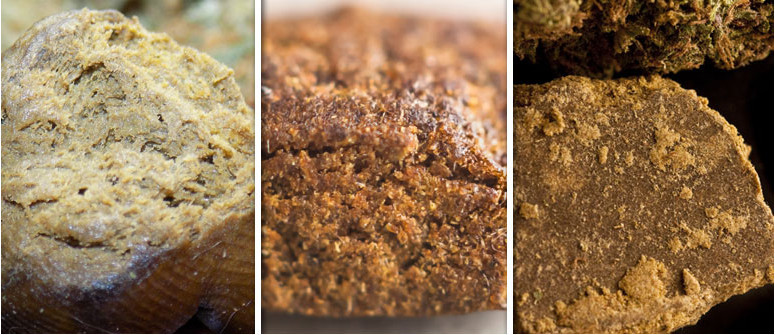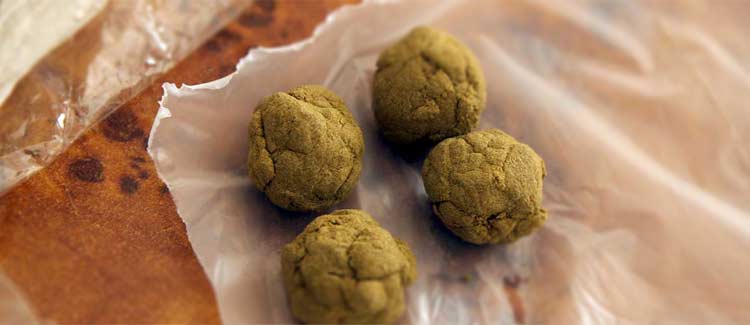How to check the quality of hash

Judging the effect and quality of hashish can be a challenge, however, there are ways to determine if it's good quality or not. Find out how here!
Judging the effect and quality of hashish can be a challenge. Unlike hash, cannabis flowers have more distinct characteristics, such as aroma and crystal coverage, all in which indicate their potency and quality. Though hashish lacks distinct features, there are ways to determine if it's good quality or not.
When looking for high-quality hashish, it's important to know what type you have. Being that hand-rubbed and dry-sift have different properties, you need not treat them equally. But for all kinds of hashish, you first need to check the aroma.
To be specific, high-quality and fresh hashish should be somewhat fragrant. However, if the product isn't fully dry, a moldy or stale smell indicates poor-quality. Specifically, hand-rubbed and ice-o-lator hash. Also, an overwhelming smell of plastic can mean that it's contaminated.
THE VISUAL CHARACTERISTICS OF GOOD-QUALITY HASHISH

Important to realize is that hashish varies widely by type. The most popular amongst coffee shops are dry-sift. By removing the dry flowers so that the trichomes are separated, one can produce dry-sift. As a result, you get kief or kif, and it then compresses together to form hash.
When it comes to good-quality dry-sift, the appearance can vary. In general, It'll be light blondish-brown and sand-like in texture. However, heavily pressed types tend to be dark brown, shiny, and hard.
When you're looking at a heavy-pressed dry-sift, the hue should appear blondish-brown when cutting open. Likewise, it should be soft and warm. However, some dry-sift hashish, typically of Lebanese origin, may seem to be more red than blonde in color.
Hand-rubbed hashish is the second most popular type that you'll find in Dutch coffee shops. Typically from Afghanistan, India, and Pakistan, this kind of hashish is a result of rubbing the living plants to remove the sticky resin. Without delay, it is then rolled into balls or eggs and left to cure before consuming or selling.
Hand-rubbed hashish should be smooth and black or brownish-black. Likewise, it tends to be sticky to the touch. However, the inside should be a soft brown, and some may even have a green tinge. Important to realize, an overly green interior can mean there's extra residual plant material.
As mentioned above, good-quality hand-rubbed hash should be rather hard when cold, and soft and flexible when warm. However, overly sticky hash, particularly when cold, can mean extra oils were added to increase the weight. Equally important is checking for fluffy white mold, which will appear if it doesn't cure correctly.
Another type that varies widely in appearance is ice-o-lator. Though not as available as others, you may find it pressed or unpressed at your local coffee shop.
When unpressed, it will appear uniform in color and have a crystally-powder look to it. Likewise, it may have small lumps due to the powder coagulating. Pressed, however, should be either light greyish-brown or dark brown. Moreover, the texture is typically soft and slightly sticky.
Full-melt types may keep their stickiness and well-defined shape at room temperature. Not to mention, they're extremely high-grade. On the contrary, lower-grades can be hard as a result of plant material. On the other hand, this doesn't necessarily mean the quality is unacceptable.
THE BUBBLE TEST: DO YOU HAVE GOOD-QUALITY HASHISH?
One of the best ways to check your hashish, no matter the type, is by doing the "bubble test". The process involves taking a piece of hash and adding a flame to it.
If the hashish is of good-quality, the resin will noticeably boil
However, even higher-grade hash often catches fire almost instantly and burns with a clean flame. Important to realize is that if the hash is black after the check, this could mean that there are contaminants, and they've combusted along with the resin. Nevertheless, using a clean flame rather than a match can prevent black soot from appearing.
If the hashish doesn't bubble, however, it may be poor in quality and possibly contain contaminants. Not to mention, high levels of remaining plant material. But, if it bubbles a little too much, this can indicate that extra oils are present.
In fact, some producers lack moral, and they will purposely add oils that create the same effect. When you combine the smells, experience, appearance, and bubble factor, you should be able to tell poor-quality from high-quality. When added oils are present, they will create a greasy appearance and plastic-like smell.
WHAT EFFECTS DO YOU WANT?
The effects of hashish vary, mainly according to the strain. However, hash from less mature plants may have different effects than hash from more mature plants, even if the strain is the same.
Hashish that is "young" and from early plants often contain a large THC-to-CBD ratio. Likewise, a higher and more strong effect. However, hashish that cures in less the amount of time before it sells can also provide greater results as less THC has degraded to CBN.
Ultimately, sativa strains produce a more intense high than indicas. Unfortunately, however, several hash-producing countries are experiencing dilution of the gene pool as a result of introducing foreign genetics. With this in mind, predicting the effects of hashish can be a challenge.
For example, ice-o-lator's results may vary according to the size of the micron. Specifically, for hybrid varities. The reason being is that sativas and indicas have different trichome sizes. In fact, sativas usually have small trichomes.
Meanwhile, indicas have larger trichomes, and hybrids contain both sizes of trichomes. With this in mind, large trichomes may separate from short trichomes during the process.




